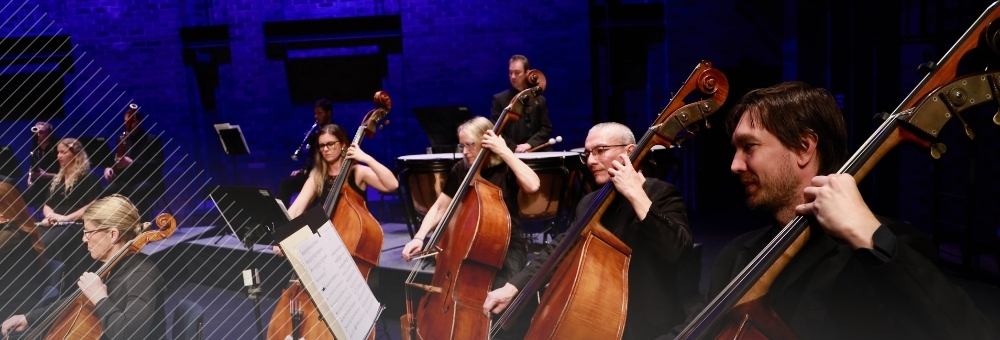7pm Saturday 1st May 2021
Everest Theatre, Seymour Centre, Chippendale
MOZART Don Giovanni Overture
KOUSSEVITZKY Double Bass Concerto
SHANNON Sequence & Variation
BEETHOVEN Symphony no 7
Conductor: Sarah-Grace Williams
Soloist Double Bass: Kirsty McCahon
Mozart, Wolfgang Amadeus (1756-1791)) | Overture to Don Giovanni |
In October 1787, Mozart premiered his opera buffa (comic opera) Don Giovanni. Following the success in Prague of his earlier opera The Marriage of Figaro, Mozart received a commission to compose an opera especially for the city. Mozart used a similar formula for the composition of Don Giovanni, using an almost identical cast, the same librettist (Da Ponte) and the same mixture of comic and serious elements.
\The opera is centred around the libertine Don Juan (Don Giovanni). The Don murders the elderly father of one of his victims in a duel. In a joking conversation with the statue of the late father, the statue surprisingly accepts the Don’s invitation, and dooms the Don after demanding repentance. The earth opens up in the climactic conclusion and the unrepentant Giovanni is swallowed by the flames of hell.
The Overture opens with a dramatic opening in D minor, the key in which the opera reaches its dramatic conclusion. This is followed by the much happier and more agreeable key of D major, however the audience is continually haunted by the sinister opening. The concert version of the Overture differs slightly to the operatic version, as the conclusion of the Overture concludes with a few final chords in D, instead of modulating and continuing to the raising of the curtains and the opening of the opera.
© Andrew Doyle 2021
| Koussevitzky, Serge Alexandrovich (1874-1951) | Double Bass Concerto |
I. Allegro
II. Andante
III. Allegro
To be able to fully understand the complexities of an instrument, it is a significant advantage if the composer is a renowned soloist on that instrument. Koussevitzky’s first orchestral position was at the Bolshoi Theatre, and in just seven years succeeded his teacher as Principal Bass. Following this position, Koussevitzky studied conducting in Berlin, and he returned to Russia to establish his own orchestra and a publishing company. His appointment as conductor of the Boston Symphony Orchestra in America lasted 25 years, in which time he established the orchestra as one of America’s most important musical organisations.
Possibly Koussevitzky’s most popular composition, the Double Bass Concerto opens with impressive fanfares, alternating with two cadenza-like statements from the solo double bass. The bass develops soulful, rich melodies in the upper range, before developing into more intense, virtuosic passages, displaying the full range of technical flair possessed by the performer. A foray into major is concluded with a return to the minor key with a flourish. Glimpses of melodic fragments flow through the Andante movement, with the bass singing the lines and providing the audience with sublime moments of beauty and reflection. The opening of the concerto is re-stated to open the final Allegro, with further development of the beauty and technical flair presented in the previous movements, combining dramatically to bring the concerto to an epic conclusion.
© Andrew Doyle 2021
| Shannon, Heather | Sequence and Variation |
The main theme of Sequence and Variation came from music which was originally written for Heather’s band The Jezabels. The theme was developed using a Prophet synthesiser and programmed as a sequence of 16 notes. The band didn’t end up using the music and so Heather adapted and arranged it for orchestra. This sequence is most clearly outlined in the 2nd movement and informs melodic material throughout the piece.
Sequence and Variation was written for the The Metropolitan Orchestra’s Composer Development Program in 2016. It is Heather’s first piece for orchestra.
© Heather Shannon 2021
| Beethoven, Ludwig Van (1770-1827) | Symphony No. 7 |
I. Poco sostenuto – Vivace
II. Allegretto
III. Presto – Assai meno presto (trio)
IV. Allegro con brio
In the bright key of A major Beethoven’s Seventh Symphony is joyful, energetic and celebratory. It is driven by dance rhythms, and Beethoven modestly believed that it was “one of the happiest products of my poor talents”. The Seventh Symphony was very well received at its premiere performance at a fundraising concert for soldiers wounded in the Napoleonic wars. The celebratory mood of the music was perfectly matched to the joy and relief the news of Napoleon’s impending defeat had already brought to the audience, and the concert was so successful it had to be repeated.
The long, expanded, typically classical introduction is marked poco sostenuto that features long scales and depicts spacious landscapes. The Vivace that replaces it becomes a joyful song and the transition between tempi uses many, many repeated E’s.
Movement two is the most famous movement from this symphony and during its premiere performance, so well was it received that a complete repeat of the movement was demanded. Beethoven moves from A minor in the Allegretto preceding movement to the relative major key, F major. He changes compositional tradition by repeating the Trio section instead of the usual single playing.
The final movement of the Seventh Symphony is relentlessly energetic. With its speed, syncopation and extreme dynamics, it is truly spectacular and is a joy to performers and listeners alike.
© Andrew Doyle 2021

